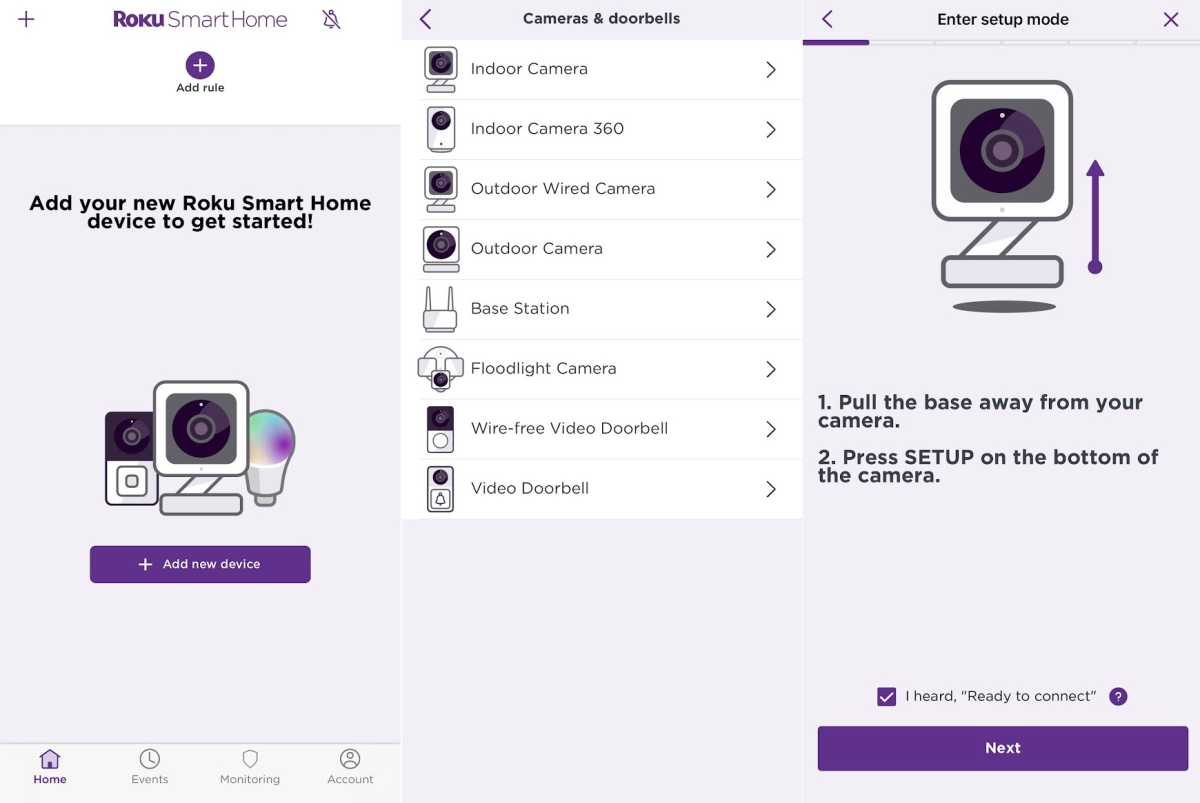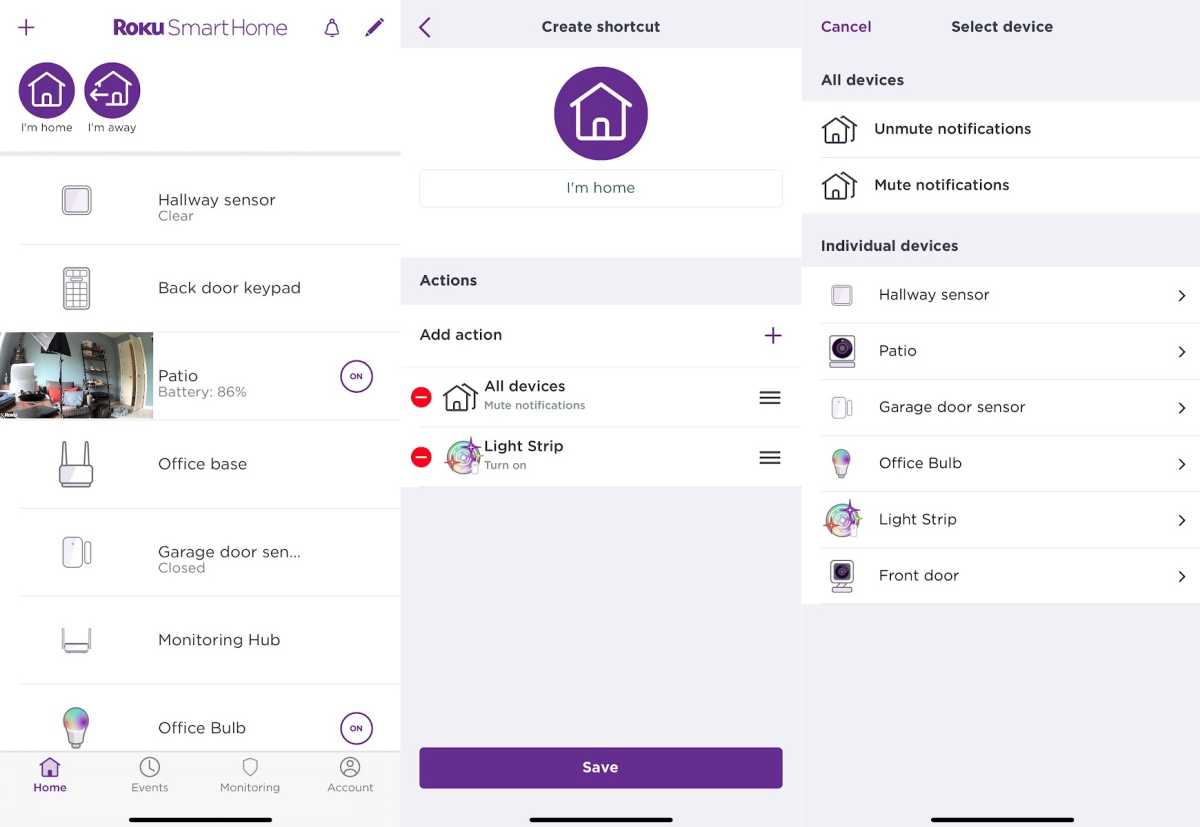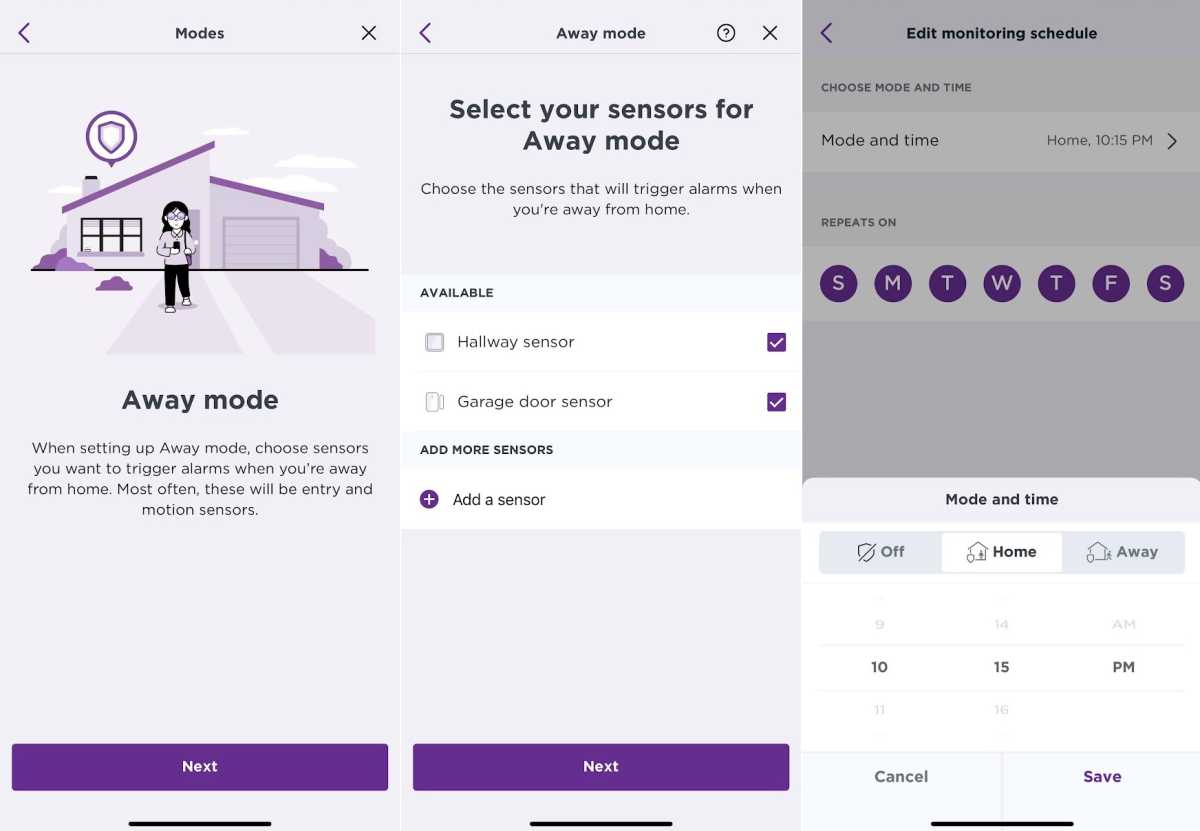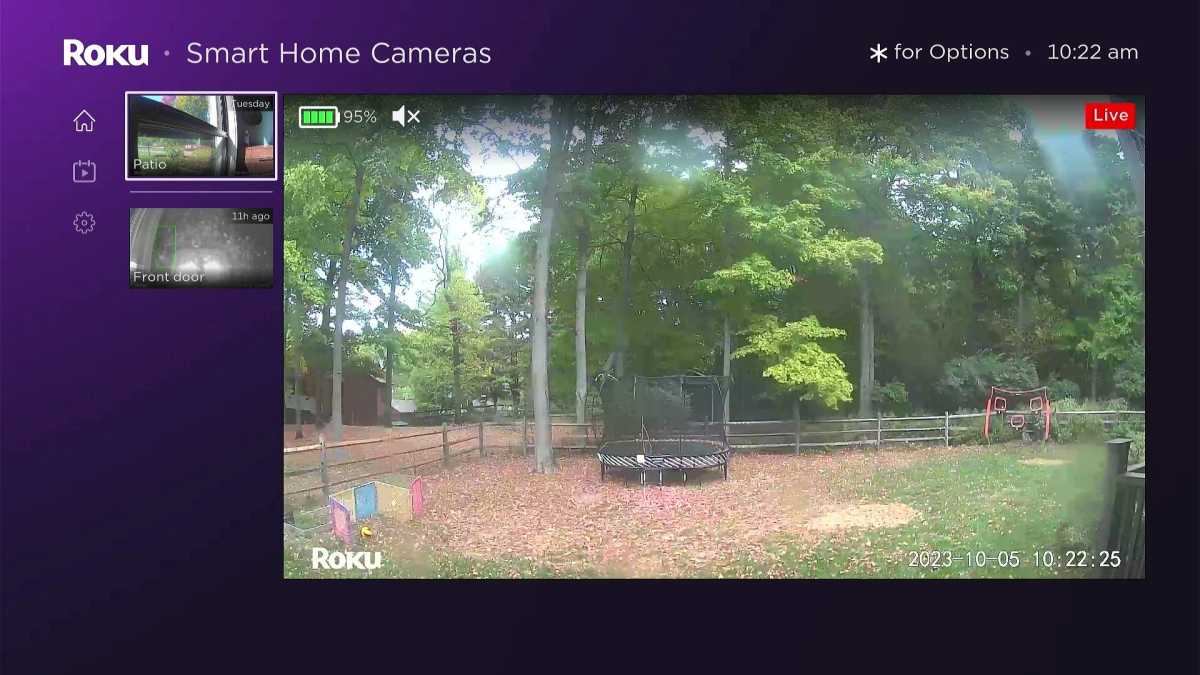At a glance
Expert’s Rating
Pros
- Basic home security at a low cost
- Supports viewing camera feeds through Roku streaming devices
- Guided home monitoring setup is helpful
Cons
- Complicated setup can lead to alert overload
- Limited device support and integrations
- Roku’s TV app has limited sensor alerts and lacks quick smart home controls
Our Verdict
Roku offers home security basics with tie-ins to its TV platform.
Price When Reviewed
$99.99 for the starter kit; as tested with indoor and outdoor cameras: $200.97
Best Prices Today: Roku Home Monitoring System SE
$99.00
Roku’s security-focused smart home system almost has nothing special to offer.
Instead of building its own products from scratch, Roku turned to Wyze Labs, the smart home company best-known for selling cheap hardware with a slew of optional subscriptions on top. The Roku Home Monitoring System SE alarm package–as well as the cameras and other add-on accessories you can add to it (including smart bulbs, light strips, and plugs)–are all nearly identical to what Wyze offers under its own brand name.
But Roku’s system has one unique selling point, at least for fans of the company’s smart TVs and streaming players: It’s the only option for checking security camera feeds through Roku’s TV interface. If your home security needs are fairly basic, that convenience might be enough to overcome the system’s limitations.
Roku’s Smart Home app is tied to the same account you use for Roku’s streaming devices, so integration is automatic.
What smart home products does Roku offer?
Like Wyze, Roku offers a starter kit that includes a hub (with an onboard siren and battery backup, but no cellular connectivity should your broadband connection go down), a keypad for arming and disarming the system, two door/window sensors, and a motion sensor. Roku’s kit is priced at $99.99.
This review is part of TechHive’s in-depth coverage of the best smart home systems.
You can mix and match other components, including cameras, lighting, and smart plugs, and manage everything with a single app. For this review, Roku also provided one Roku Indoor Camera SE ($26.99), a 1080p security camera resolution that can store recordings locally if you provide a microSD card; and one Roku Outdoor Camera SE ($73.99), a weatherized (IP65), battery-powered camera with a base station that can support up to three additional cameras (the base station also has a microSD card slot).
Roku also sells a video doorbell ($79.99, or $99.99 if you add a chime), a wireless pan/tilt indoor camera ($39.99), a wired outdoor camera ($49.99), a wired floodlight camera ($99.99), and a solar panel for its outdoor cameras ($24.99). Beyond the security realm, Roku’s smart home device options are limited: There are smart A19 bulbs in white or color, smart 16- and 32-foot light strips, and both indoor and outdoor smart plugs. Roku did not provide these additional products for this review. As of this writing, there are no options for recessed lighting, smart locks, thermostats, garage door control, smoke detectors, or water leak sensors.
What are Roku’s security subscription fees?
Roku has the same subscription structure as Wyze, with separate options for its cameras and home monitoring system.
On the camera side, Roku charges $4 per month or $40 per year for a single camera, or double that amount for two cameras. A plan for up to 100 cameras costs $10 per month or $100 per year. The subscription stores the past 14 days in the cloud and lets you get separate notifications for people, pets, packages, and vehicles. Without a subscription, you can view live camera footage, store recordings on a microSD card you supply, and get motion alerts, but there will be a 5-minute cool-down period between those alerts.
Professional monitoring is provided by Noonlight and requires a separate subscription at $10 per month or $100 per year. Subscribers get round-the-clock monitoring from live U.S. agents and an option to summon emergency dispatchers through the app. Without a subscription, you’ll still get alerts on your phone, but will be on your own to deal with them.
Roku home security: The setup

Jared Newman / Foundry
For device setup, you’ll use Roku’s Smart Home app for iOS or Android. After signing into your Roku account—or creating a new one—you must pair each device one-by-one, including all the individual sensors for Roku’s alarm system.
The exact setup steps vary for each device, but Roku’s app does a nice job guiding you through the process. With the indoor camera, for instance, there’s a button on its underside that puts it into setup mode. You then enter your Wi-Fi credentials in Roku’s mobile app and point the camera at a QR code on your phone screen to make the connection.
Installing the outdoor camera base station does have one minor annoyance: It must be plugged into your router via ethernet during the setup process. You can connect the base station to Wi-Fi after the initial setup, but the app doesn’t make this clear at the beginning.
Is Roku’s home security system easy to use?

Jared Newman / Foundry
Roku’s streaming TV devices focus on simplicity almost to a fault, but that’s not the case in the smart home space, where Roku is essentially just using reskinned versions of Wyze’s apps.
Out of the box, Roku’s app will hit you with notifications for every motion and sensor event, with no guidance on how to pare things back. If you want fewer alerts, you’ll need to take some extra steps.
For the alarm system, your first stop should be the app’s Monitoring tab, which guides you through the process of adding sensors and setting up home and away modes. This includes setting up Roku’s keypad and deciding which sensors can trigger the alarm when the system is armed. This is an important part of the setup, but it’s easily missed as part of the initial installation.

Jared Newman / Foundry
The next step is to explore the app’s “Rules” system, which can enable or disable alerts based on context. For instance, you can have an “I’m Home” rule that disables all indoor cameras and turns off door sensor alerts, or an “Away” rule that turns everything back on. Those rules can be activated manually through the app or alarm keypad, or automatically based on things like the time of day or your phone’s location.
The Rules system allows you to chain events together as well. For example, you can turn on a group of light bulbs when a nearby camera detects motion, or trigger a camera’s siren if a door sensor has been left open for too long.
Roku’s cameras also offer sensitivity settings and motion alert zones, which can help avoid false positives if a bug flies into view or a car passes by on the street. You can filter out alerts from people, pets, packages, or vehicles as well, but only with a camera subscription.

Jared Newman / Foundry
Despite the complexities, the system has its limitations. Phone location triggers are limited to a single user, so multi-person homes can’t turn on the cameras until after everyone has left, and you can’t filter out triggering conditions; for instance to only turn on a camera when no one’s home during nighttime hours.
Automation is also limited by the small number of devices that Roku offers. If you want your security camera to automate other devices, such as thermostats or smart locks, you’ll need to tie it into broader platforms such as Amazon Alexa or Google Home (more on that shortly).
One last nitpick: Roku does not offer a web or desktop interface for viewing camera events or controlling smart home devices. Everything must flow through its mobile app instead.
Roku home security on your TV

Jared Newman / Foundry
Because Roku’s Smart Home app is tied to the same account you use for Roku’s streaming devices, integration is automatic. Using voice commands on a Roku remote, you can view live camera feeds, control the lights, and toggle your smart plugs. The Roku Cameras app also lets you view live camera footage and motion alert history.
The integration could go a lot further, though. As of now, you can’t get on-screen alerts for anything except doorbell events and security alarms. That means there’s no way to mirror the basic sensor alerts you get on your phone unless your security system is armed.
Unlike with Alexa devices on Fire TV or HomeKit devices on Apple TV, Roku also doesn’t offer any kind of dashboard for controlling lights, smart plugs, or automations. You’re entirely dependent on the voice remote for these functions.
One other issue that came up in testing: After the Roku camera subscription expired, motion events disappeared from Roku’s TV app while remaining available in the mobile app. Roku doesn’t advertise motion events on TV as a subscription-only feature, so we’ve reached out to the company for clarification.
Roku’s semi-walled security garden
Roku’s home security system is not entirely cut off from the broader smart home world. With both Google Home and Alexa, you can connect your Roku account so they can access the company’s smart home devices. You can then use voice commands on an Amazon Echo or Google Nest speaker to control Roku’s lights or smart plugs, or view Roku camera footage through Fire TV and Google TV devices.
Connecting to Google Home or Alexa also opens up broader automation potential. For instance, if you want to adjust a Nest thermostat or control a Yale smart lock in response to motion from a Roku camera, you can set that up with Alexa Routines or Google Home automations.
Just be aware that these connections have limits. You can’t use Roku’s smart home sensors to trigger routines with Google Home or Alexa, and Camera detection is also limited to basic motion, with no filters for things like people or pets. Roku doesn’t tie into Apple’s HomeKit or Siri either, so you can’t use voice commands on an iPhone or HomePod to control Roku’s devices.
Is Roku home security worth it?
Roku’s system works well enough for basic security and monitoring, but it’s limited by a narrow range of devices and integrations. It’s also not much different from Wyze’s own smart home system, which offers a much broader range of devices including leak sensors, door locks, and garage door controllers.
As such, the only reason to consider Roku’s security system is if you’re deeply invested in the company’s smart TVs and streaming players. Being able to check your cameras through the TV is a welcome convenience, but it’s also one that other streaming devices support through a wider range of camera makers. Those without a strong allegiance to Roku will be better off looking to more robust security systems—and perhaps a more compatible streaming platform to go with it.
Correction: An earlier version of this review stated that Roku TV devices do not show alerts for home security sensors. Those alerts do appear on the TV, but only when the security system is armed.

